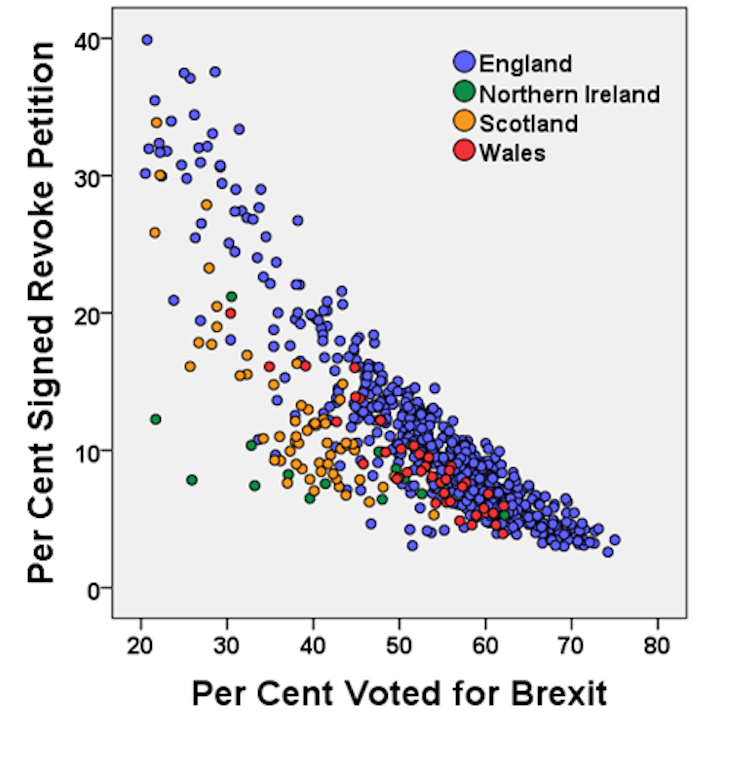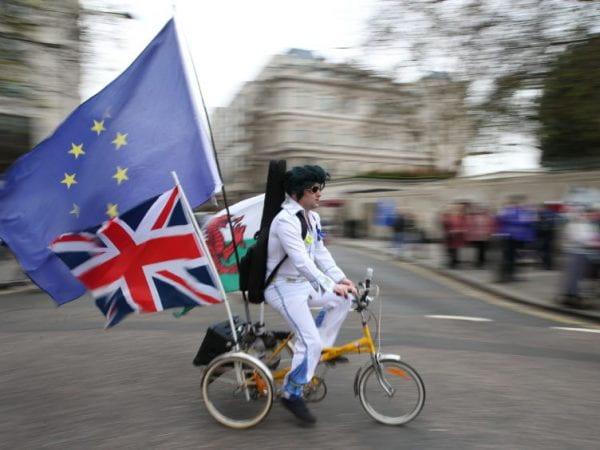Image credit: PA/Aaron Chown
Ron Johnston, University of Bristol; Charles Pattie, University of Sheffield, and David Manley, University of Bristol
Not surprisingly, much public attention has been given to the online petition asking parliament to revoke Article 50 so that the UK will remain within the European Union. It attracted more than 5m signatures within a week of being launched, making it the most signed petition since the government’s e-petition site began. It crashed the system multiple times over the course of the first few days.
Critics of the petition, largely drawn from those who promoted and continue to support Brexit, claim that it is yet another attempt by those who opposed Leave to subvert the democratic decision reached by a clear majority in the June 2016 referendum. They claim that many of those opposed to leaving the EU cannot accept that decision and are using whatever methods they can to overturn it.
Are they right? The numbers signing the e-petition are remarkable. But even if we assume (as seems reasonable) that almost all signatories were Remain voters, most Remainers have not (yet) signed. As of the time of writing, two-thirds had not done so. This does not mean, of course, that those who have not signed are therefore opposed to the petition (we cannot know – and there may well be people who have not signed because they never sign petitions at all, even when they support a petition’s cause).
But we can assess whether support for revoking Article 50 is related to support for Remain by comparing their respective geographies. Data are available on the number of signatories to the petition in each of the UK’s 650 parliamentary constituencies (signatories were asked to give a postcode, and this can be matched to the relevant constituency).
As of March 25 the spread varied considerably. Only 2.6% of the people registered to vote in Walsall North in 2018 (1,722), for example, had signed the 2019 petition. Meanwhile, over in Bristol West, 39.9% of the electorate had signed. By comparison, estimates suggested that 74.2% of Walsall North’s voters supported Brexit in 2016, compared to just 20.7% in Bristol West. These extremes are at the ends of a clear continuum for all 650 UK constituencies: the larger the vote for Brexit in 2016 the smaller the percentage who have signed the petition.

There are some variations around this general trend, however. For instance, far fewer voters in Wales, Scotland and, especially, Northern Ireland have supported the petition than in England. This is particularly surprising given that both Northern Ireland and Scotland voted to remain in 2016. A statistical model describing the general trend allows us to predict what the typical percentage signing the petition would be in constituencies with different Brexit votes in 2016. Based on such a model, we calculate that in English constituencies where 50% supported Leave in the referendum, on average about 13% signed the petition. In similar Scottish constituencies, it was only 6.1% and in Northern Ireland only 5.4%. Wales, of course, voted Leave, but in constituencies there where around 50% voted to leave, support for the petition now was about 10.4%.
For some reason, support for revoking Article 50 (as measured by this petition at least) has been smaller in the UK’s Celtic fringe.
The critics – not surprisingly – are right, at least in the sense that the petition appeals most to Remain supporters. The geography of support for revoking Article 50 and the UK remaining in the EU is very largely the same as the geography of support for Remain three years ago: on average there has been no change – although we have to wonder why the Scots and Northern Irish have been relatively silent this time.![]()
Ron Johnston, Professor of Geography, University of Bristol; Charles Pattie, Professor of Electoral Geography, University of Sheffield, and David Manley, Professor of Human Geography, University of Bristol
This article is republished from The Conversation under a Creative Commons license. Originally published 25th March 2019. Read the original article

